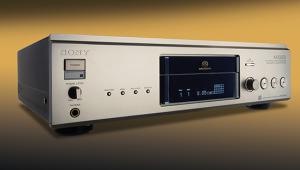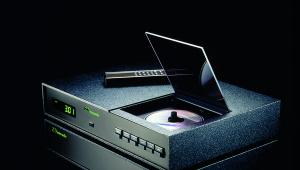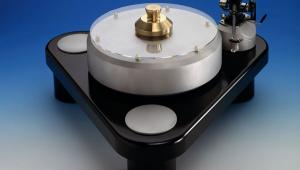Tron Nucleus/PX25/300B Amplifiers Page 2
![]() Sheer Class
Sheer Class
For this review, I was loaned a complete system, consisting of Nucleus Line preamplifier, Nucleus Phono preamplifier with both the Type 300B and the Type PX25 power amplifiers, along with Tron's own interconnects. For Compact Disc I used mainly the Exposure CDP and Musical Fidelity E624; vinyl replay was via a Roksan Xerxes/Artemiz and various cartridges, the Avid Acutus with SME Series V arm and van den Hul Frog cartridge; and an SME Model 20 turntable with SME V arm. The speakers used included AvantGarde Uno horns along with a variety of others.

I started, in fact, with the Nucleus/Type PX25 combination feeding the Unos, and with the then-resident Acutus record deck as a source. The sheer class of the Tron amplification was immediately obvious. It created a big soundstage, with tremendous detail and that unmistakeable single-ended strength of abundant life and excitement. (The Uno loudspeaker has its own active bass section, operating below 150Hz; although driven via the main amplifier's speaker terminals, this means you cannot really use the AvantGarde Unos to judge amp bass quality.)
I didn't find it hard to understand why a lot of users have fallen for the PX25, but here I was being offered the choice between this and the 300B. Graham Tricker, a shrewd judge of character as well as of valve sound, quickly decided that I was a '300B type' and immediately shipped over the Type 300B. Side-by-side comparison certainly revealed a quite different balance. If you'd become accustomed to the PX25, you'd probably say the 300B was soft; yet I found that, in Tron's application, it gave me the classic single-ended virtues in a more completely enjoyable form. The soundstage was much less forward. I would say it was between and behind the speakers now, rather than level with them or projecting – but this might give a somewhat misleading idea of the AvantGarde Unos, because whatever source you use, these speakers seem to bring the music into the room, rather than leaving it outside the window behind, and without ever being too 'forward'. The 300B sound really did have more of that 'liquid' midrange smoothness, and a warmer balance that would perhaps be kinder to rougher sources.
Quiet Revolution
When it came to signal-to-noise ratio, the Tron pre- and power amplifiers all performed as advertised, and were superbly quiet with the 99dB/1W sensitivity AvantGarde Unos. I'm sure there are other valve amp manufacturers whose hearing has developed a notch filter at 100Hz, and a severe treble roll-off, as they don't seem bothered by levels of power-supply buzz and sizzling hiss which would upset any normal person living in this world of silicon semiconductors. With Tron, though, there really is no compromise in this respect. You switch on, and the music comes with no more fuss than with any solid-state amplifier.

During the review period, I was also able to compare the Tron 300B with a well-used AudioNote Conqueror amp, using AudioNote-branded 300Bs. Although in its day a less expensive product, the Conqueror stood up quite well in this comparison, if not actually living up to its name. (It usually does when put up against most solid-state amplifiers.) It was certainly not as quiet as the virtually noise-free Tron design (the sample may or may not be typical), but it seemed to have, if anything, an even greater feeling of freedom, an effortless quality, like a well run-in engine. Yet somehow the Tron 300B could produce an amazing soundstage, where things happened in the 'back corners'; some subtle limitations of staging which I had previously ascribed to my listening room were magically overcome. In this aspect, it showed its superiority, and I suspect that all the careful work that has gone into making it so very quiet has also helped when it comes to low-level detail and ambience retrieval.
A very common criticism of single-ended triodes is that they have no bass. To assess this aspect of the performance, I hooked up the Tron power amps to a pair of Rogers Studio 7 speakers. In theory, this was a far from sensible combination, as sensitivity is well below 90dB/1W, so you cannot expect realistic concert-hall levels. You can get nice sounds, though. Predictably, the bass was light, but had a natural, unforced quality. On the other hand the '300B midrange', combined with the Studio 7s' well-tuned dispersion characteristics, ensured these loudspeakers produced a soundstage that was broad and beautifully airy.
Conclusion
Summing up the achievement of these Tron products is not easy, especially when the alarming effect of accumulating price tags has to be taken into account. The Type PX25 power amplifier is £5150, but if you are ready for that kind of expense the £5750 of the Western Electric-equipped Type 300B version will not, and should not, dissuade you. (In the middle, at £5570, comes the KR 300B 'high power' version.)
The line preamp and phono stage are now £3100 each, which is not a small sum. So we are looking at an amplifier system costing, by the time you've treated yourself to a couple of audiophile LPs to play on it, very nearly £12,000! It is a keen enthusiast who will pay such a sum for an amplifier that offers less than 10W power output, no remote control and in which the active devices amount to a total of fewer than a dozen valves.

Tron Legacy
So the question is not whether such products are good value for money, but whether they justify their existence. I think they do. You can get most of what the Tron amplifiers do for a lot less, but you can't get all of it. Graham Tricker set out to produce a very high quality design that would do justice to the best high-sensitivity loudspeakers, and he has succeeded. If you are lucky enough to be able to afford the big AvantGarde Uno models, the Tron amp provides the perfect match. And for the rest of us? In their combination of meticulous build quality, sound and general integrity, the Tron products set standards for others to match. We can be glad they are British.
Also In HFN This Month In 1999
HI-FI SHOW '99 CHICAGO
Ken Kessler returns to the Windy City for the US Stereophile show.
B&W NAUTILUS 803
Nautilus engineering in a smaller package. Martin Colloms hears the series' third speaker.
TRAXDATA CDRW2260
Andrew Harrison on an all-in-one kit for creating CDs at home.
PIONEER DVL-919E
Ken Kessler hears a combined DVD-Video and LaserDisc player for silver discs big and small.
TANNOY R2 SPEAKERS
The second revolution as Tannoy speakers become floorstanding. Alvin Gold assesses their sound.
PATHOS TWIN TOWERS
Ken Kessler reviews a hybrid valve and MOSFET amplifier.
McCORMACK MICRO PHONO DRIVE
James M Hughes tests a phono preamplifier for moving-magnet and moving-coil pick-ups.
LiNN CD12
Christopher Breunig and Steve Harris meet the CD12 player.
PRO-JECT 9.2
Tony Bolton hears the arm on a Thorens TD 160B Mk II deck.


















































